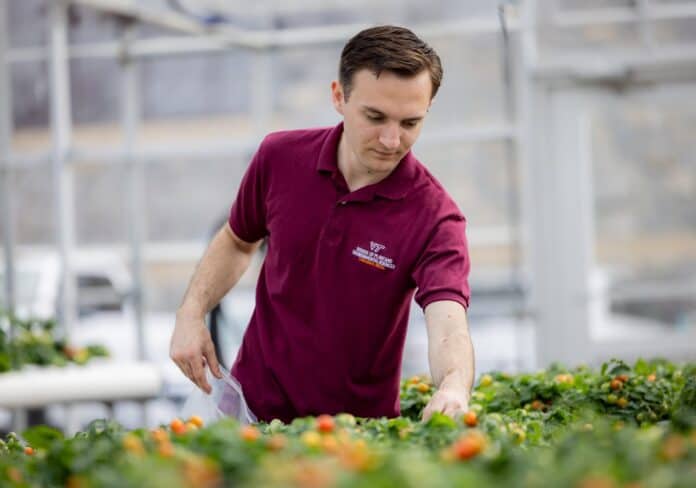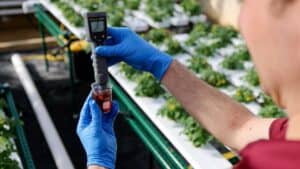Virginia Tech researchers are revolutionizing the way food is grown, using advanced technology to cultivate flavorful, high-yielding crops in indoor environments.
Contributing to this novel research is Brandan Shur, a first-year Ph.D. student in the College of Agriculture and Life Sciences. Shur’s work at the Controlled Environment Agriculture (CEA) Innovation Center focuses on optimizing controlled environments to enhance the yield and taste of hydroponic crops – primarily focusing on micro-dwarf tomatoes and expanding into new crops such as watercress.
“In CEA, we’re not just growing plants – we’re fine-tuning conditions to optimize plant performance,” Shur said. “By precisely controlling factors like light, temperature, and nutrient composition, we can push the boundaries of what’s possible with crop production. The goal is to grow food that’s not only resource efficient but also better-tasting.”
These studies have far-reaching implications for urban agriculture, vertical farming, and food security, providing a blueprint for how crops can be grown more efficiently in controlled environments.
“This research is more than just academic — it’s about solving real-world problems,” said Shur. “With land and resources becoming more limited, we need new ways to produce high-quality food in smaller spaces. CEA gives us that opportunity.”
Unlocking the potential of micro-dwarf tomatoes
One of Shur’s primary research projects is exploring the potential of micro-dwarf tomatoes as a high-value crop for hydroponic growing systems. These tiny but tasty plants are compact, fast-growing, and, under the right conditions, capable of producing exceptional yields.
Early trials have shown that micro-dwarf tomatoes grown in controlled environment agriculture can outperform traditional farming methods, producing more fruit per square area while using fewer resources. But yield is just one part of the equation – flavor is just as important.
“A lot of people think hydroponic tomatoes don’t taste as good as field-grown ones, and they may often be right,” said Shur. “But what if we could change that? Our research is focused on manipulating the environment to enhance natural sugars, acidity, and aromatic compounds to create a tomato that’s just as flavorful, if not more, than what you’d find in a grocery store.”
By testing different nutrient concentrations and environmental conditions, Shur is working to crack the code of tomato flavor chemistry, potentially making micro-dwarf tomatoes a game-changer for indoor farming and greenhouse growing.
“Micro-dwarf tomatoes have the potential to redefine how we think about fresh produce in urban areas,” said Michael Evans, professor in the School of Plant and Environmental Sciences and co-director of the Controlled Environment Agriculture Innovation Center. “Brandan’s work is key to proving that these small plants can have a big impact on the future of controlled environment agriculture. We need more crop diversity in hydroponic systems. Right now, most commercial indoor farms focus on leafy greens, but expanding into fruiting crops like tomatoes could make these systems more versatile and economically viable.”
While Shur’s work with micro-tomatoes highlights the transformative potential of controlled environment agriculture, another initiative at the School of Plant and Environmental Sciences is exploring the cultivation of watercress using hydroponic systems. Evans and his team have been researching the potential of growing watercress in a Nutrient Film Technique system. Recognized by the Centers for Disease Control and Prevention as the single most nutrient-dense fruit or vegetable, watercress achieved a perfect score of 100 in the powerhouse fruits and vegetables ranking. This distinction underscores its potential as a valuable crop for improving diets and human health.
“We’re starting this project by researching the nutritional demands of watercress to better understand its needs in a hydroponic system,” said Evans. “By identifying the optimal nutrient formulation, we aim to maximize growth, yield, and nutritional quality while ensuring efficient resource use. We’ve seen great yields for this fast-growing crop so far.”


